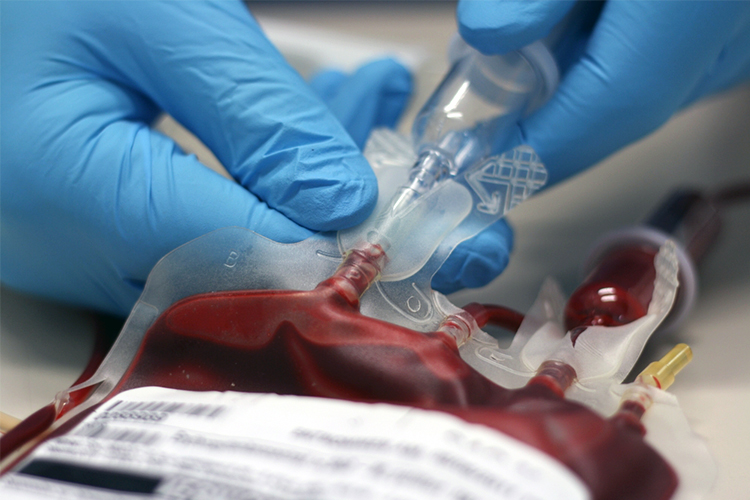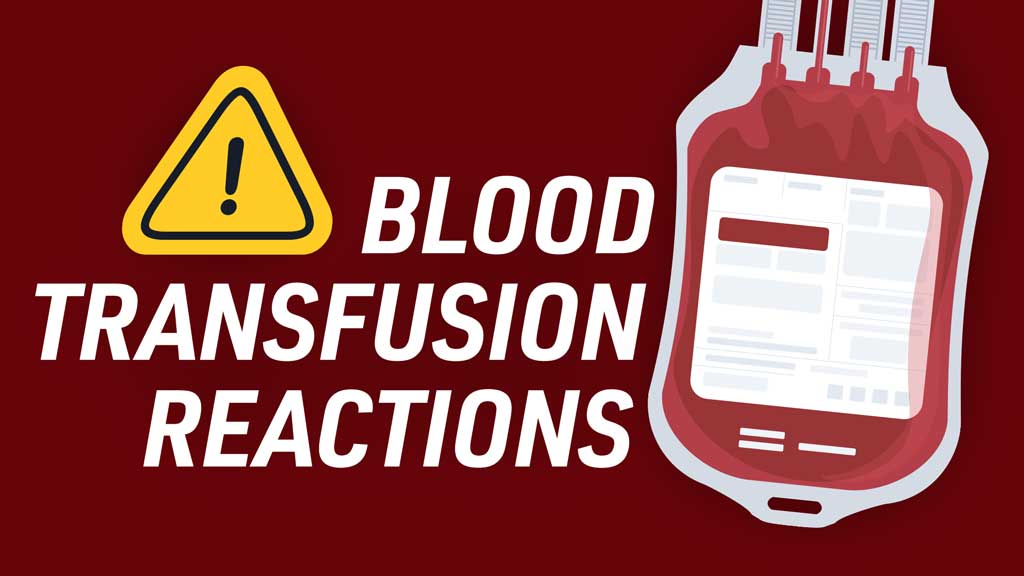If you haven’t administered a blood transfusion as a nurse, chances are you personally know someone who has been on the receiving end of one. They are a common occurrence in hospital settings and are therefore a common area of risk within healthcare.
There are basically two different types of risks when giving blood. The first relates to procedural errors that may occur, such as placing incorrect labels on blood sampling tubes. The second area of risk relates to transfusion reactions. This is why Standard 7 of the National Safety and Quality Health Service (NSQHS) Standards is focused on blood and blood products.
Nursing care of the patient undergoing a blood transfusion is of utmost importance. Nurses are responsible not only for the actual administration of the blood product and monitoring of the patient during its administration but also efficiently identifying and managing any potential transfusion reactions. It’s important to remember that transfusion reactions may occur during the actual blood transfusion as well as in the days and weeks following the administration of the blood product (Watson & Denison 2014).
Although blood transfusion reactions are rare, it is important that any nurse who administers a blood product is aware of potential reactions and knows how to manage these reactions safely and effectively.
Acute Haemolytic Transfusion Reaction
This type of reaction most commonly occurs when incompatible red blood cells are transfused into the patient. For example, if the patient’s blood group is A positive, but they receive B positive blood.
The reaction will begin during the first few minutes of transfusion, with the patient often complaining of feeling a sense of ‘impending doom’ as well as flushing, chills, rigors, dyspnea and abdominal pain. Physiologically, they will also become tachycardic, febrile and hypotensive (Lifeblood 2021a; Crisp & Taylor 2012).
Febrile Reactions
The patient may become febrile during the blood transfusion and for up to four hours following its completion. This is due to the antigens in the administered blood reacting to the patient’s white cell antibodies. This increase in temperature can often be an isolated finding during routine monitoring and is one of the most common reactions that individuals experience in response to blood transfusions (Lifeblood 2021a; Crisp & Taylor 2012; Watson & Denison 2014).
Allergic Reactions
Allergic reactions to blood products, like any other allergy, vary from person to person and range from anaphylaxis to a rash. Mild reactions have been found to occur in between 1 to 3% of patients undergoing a transfusion. Anaphylactic reactions are much less common, occurring in up to 1 in 20,000 blood transfusions (Lifeblood 2021a).
In the case of a mild allergic reaction such as itching where the patient is physiologically stable, the infusion may be stopped and then restarted at a slower rate with the addition of an antihistamine medication being administered to the patient (Lifeblood 2021a; Watson & Denison 2014).
Transfusion-Transmitted Infection
This blood transfusion reaction results from either bacterial or viral contamination of blood products. The patient will often show symptoms within a short time after the infusion has commenced, and these symptoms may be quite similar to those of other reactions, including hypotension, increased temperature, rigors, tachycardia, nausea and vomiting, and dyspnea. However, with a transfusion-transmitted infection, the patient may also go into shock (Lifeblood 2021a; Watson & Denison 2014).
In this situation, blood cultures should immediately be taken and intravenous broad-spectrum antibiotics administered. The unit of blood should be sealed (to prevent leakage) and returned to the blood laboratory, and the blood transfusion centre should be contacted (Watson & Denison 2014).
Transfusion-Related Acute Lung Injury
This reaction is thought to occur when the antibodies in the donor plasma react with the patient’s white cells. This activates inflammatory cells in the lungs, causing the leaking of plasma into the alveolar spaces and resulting in pulmonary edema in the patient (Watson & Denison 2014).
It generally occurs within six hours of the transfusion. The patient will present with fever, rigors, hypotension, tachycardia, hypoxemia, and tachypnea. They will also be severely short of breath with a productive cough of frothy pink sputum (Lifeblood 2021a; ACT Health 2017).
Transfusion-Associated Circulatory Overload

When too much blood is transfused too quickly into a patient, it may cause acute left ventricular failure, which is also called transfusion-associated circulatory overload. This generally occurs in older adults and neonates. The patient will present with respiratory distress, tachycardia, hypertension, acute or worsening pulmonary edema and a positive fluid balance (Lifeblood 2021a; Crisp & Taylor 2012).
Delayed Haemolytic Transfusion Reactions
This reaction occurs when a patient has an antibody (that has not been detected in previous blood screening) that reacts to an antigen within the transfused blood cells. It may cause red cell breakdown (hemolysis). Symptoms generally occur between 24 hours and four weeks following the infusion rather than straight away.
You may notice that the patient’s hemoglobin continues to fall following the transfusion (although immediately after they may have an increase, it will then decline). They may also have jaundice, fever or even show signs of acute renal failure (Lifeblood 2021a; Watson & Denison 2014).
Transfusion-Associated Graft-Versus-Host Disease
Once again, this is a delayed transfusion reaction that occurs one to two weeks following the transfusion. It is the result of some residual white cells that were left in the transfused blood beginning to duplicate, causing an immune response in the patient. This reaction generally occurs in those who are already immunocompromised.
The patient may show signs of fever, rash, diarrhoea, impaired liver functioning and bone marrow aplasia. It is also important to note that this complication is nearly always fatal due to the subsequent infections that develop in the patient's immunocompromised state (Lifeblood 2021a; Watson & Denison 2014).
Post-Transfusion Purpura
This is another delayed-onset transfusion reaction that occurs 7 to 10 days following the transfusion. It is a rare reaction that results in patients having a low platelet count due to the presence of a platelet-specific antibody in the blood. As a result of this, the patient may show some signs of excess bleeding, including episodes of epistaxis (Lifeblood 2021a).
In 9% of patients, this reaction can be fatal, usually as a result of the patient experiencing an intracranial hemorrhage (Watson & Denison 2014).
If You Suspect a Transfusion Reaction:
Generally, if you suspect that your patient is having a transfusion reaction you should follow these steps (and ensure you follow your hospital guidelines):
- Stop the transfusion immediately.
- Check and monitor the patient's vital signs.
- Maintain intravenous access (do not flush existing line and use new intravenous access if required).
- Check that the correct blood bag has been given to the correct patient.
- Notify your medical officer and transfusion service provider.
(Lifeblood 2021b)
Conclusion
As you can see, there are many potential reactions from blood transfusions that can occur. This means that nursing care and monitoring of patients receiving transfusions is essential in order to identify early those who may be having a reaction, and ensure effective treatment is implemented immediately.
Test Your Knowledge
Question 1 of 3
What percentage of patients experience anaphylactic reactions to blood products?
Topics
References
- ACT Health 2017, Canberra Hospital and Health Services: Clinical Procedure: Fresh Blood Products Administration – Adults, Paediatrics (Including Mature Minors), Infants and Neonates, Australian Capital Territory Government, viewed 18 October 2023, https://www.health.act.gov.au/sites/default/files/2019-02/Fresh%20Blood%20Product%20Administration.docx
- Crisp, J & Taylor, C 2012, Potter & Perry’s Fundamentals of Nursing, 4th edn, Elsevier, Marrickville.
- Lifeblood 2021a, Adverse Events, Australian Red Cross, viewed 18 October 2023, https://www.lifeblood.com.au/health-professionals/clinical-practice/adverse-events
- Lifeblood 2021b, Management of Suspected Reactions, Australian Red Cross, viewed 18 October 2023, https://www.lifeblood.com.au/health-professionals/clinical-practice/adverse-events/management-of-suspected-reactions
- Watson, D & Denison, C 2014, ‘Blood Transfusion 4: Recognizing and Managing Transfusion Reactions’, Nursing Times, vol. 110 no. 39, viewed 18 October 2023, https://www.nursingtimes.net/clinical-archive/critical-care/recognising-and-managing-transfusion-reactions/5074980.article
 New
New 
